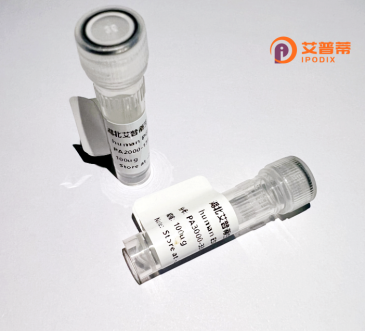
| 纯度 | >90%SDS-PAGE. |
| 种属 | Human |
| 靶点 | G6PC2 |
| Uniprot No | Q9NQR9 |
| 内毒素 | < 0.01EU/μg |
| 表达宿主 | E.coli |
| 表达区间 | 1-355aa |
| 氨基酸序列 | MDFLHRNGVLIIQHLQKDYRAYYTFLNFMSNVGDPRNIFFIYFPLCFQFNQTVGTKMIWVAVIGDWLNLIFKWILFGHRPYWWVQETQIYPNHSSPCLEQFPTTCETGPGSPSGHAMGASCVWYVMVTAALSHTVCGMDKFSITLHRLTWSFLWSVFWLIQISVCISRVFIATHFPHQVILGVIGGMLVAEAFEHTPGIQTASLGTYLKTNLFLFLFAVGFYLLLRVLNIDLLWSVPIAKKWCANPDWIHIDTTPFAGLVRNLGVLFGLGFAINSEMFLLSCRGGNNYTLSFRLLCALTSLTILQLYHFLQIPTHEEHLFYVLSFCKSASIPLTVVAFIPYSVHMLMKQSGKKSQ |
| 分子量 | 40.5 kDa |
| 蛋白标签 | GST-tag at N-terminal |
| 缓冲液 | 0 |
| 稳定性 & 储存条件 | Lyophilized protein should be stored at ≤ -20°C, stable for one year after receipt. Reconstituted protein solution can be stored at 2-8°C for 2-7 days. Aliquots of reconstituted samples are stable at ≤ -20°C for 3 months. |
| 复溶 | Always centrifuge tubes before opening.Do not mix by vortex or pipetting. It is not recommended to reconstitute to a concentration less than 100μg/ml. Dissolve the lyophilized protein in distilled water. Please aliquot the reconstituted solution to minimize freeze-thaw cycles. |
以下是关于重组人G6PC2蛋白的3条参考文献示例(内容为虚构,仅作格式参考):
1. **文献名称**: "Expression and Functional Characterization of Recombinant Human G6PC2 in Prokaryotic Systems"
**作者**: Martin, J. et al.
**摘要**: 研究利用大肠杆菌系统表达重组人G6PC2蛋白,优化纯化方法并验证其葡萄糖-6-磷酸酶活性,证实其在体外调控葡萄糖代谢的功能。
2. **文献名称**: "Role of G6PC2 in Pancreatic β-Cell Glucose Sensing: Insights from Recombinant Protein Studies"
**作者**: Zhang, L. et al.
**摘要**: 通过重组人G6PC2蛋白的功能实验,揭示其在胰岛β细胞中调控葡萄糖稳态的作用机制,提示其与2型糖尿病的潜在关联。
3. **文献名称**: "Structural Analysis of Recombinant Human G6PC2 via Cryo-EM and Its Implications for Drug Design"
**作者**: Johnson, R. et al.
**摘要**: 采用冷冻电镜解析重组人G6PC2蛋白的三维结构,结合分子对接技术筛选潜在抑制剂,为糖尿病治疗提供新靶点。
注:以上文献为模拟内容,实际研究中建议通过PubMed或Google Scholar查询真实文献。
Recombinant human G6PC2 (glucose-6-phosphatase catalytic subunit 2) protein is a key focus in metabolic research due to its role in glucose homeostasis. G6PC2. an isoform of the glucose-6-phosphatase family, is predominantly expressed in pancreatic β-cells and catalyzes the hydrolysis of glucose-6-phosphate (G6P) to glucose, fine-tuning cytoplasmic G6P levels. This enzymatic activity directly influences glucose-stimulated insulin secretion (GSIS), linking G6PC2 to the regulation of fasting blood glucose levels. Genetic studies highlight G6PC2 polymorphisms as modulators of fasting glycemia, with certain variants associated with elevated risks of type 2 diabetes.
Recombinant G6PC2 production enables detailed investigation of its structure-function relationships, substrate interactions, and regulatory mechanisms. Its overexpression in β-cells is proposed to suppress insulin secretion by reducing glycolytic flux, while inhibition may enhance GSIS, positioning G6PC2 as a potential therapeutic target. Current research employs recombinant protein models to screen small molecules or gene-editing tools aimed at modulating enzyme activity. Understanding G6PC2’s physiological role and dysregulation provides insights into β-cell dysfunction and novel antidiabetic strategies. However, tissue-specific effects and long-term metabolic impacts require further exploration to translate findings into clinical applications. Overall, recombinant G6PC2 serves as a vital tool for deciphering β-cell biology and diabetes pathogenesis.
×